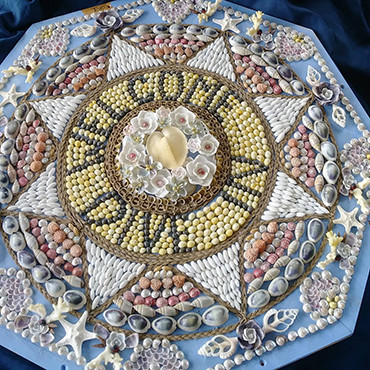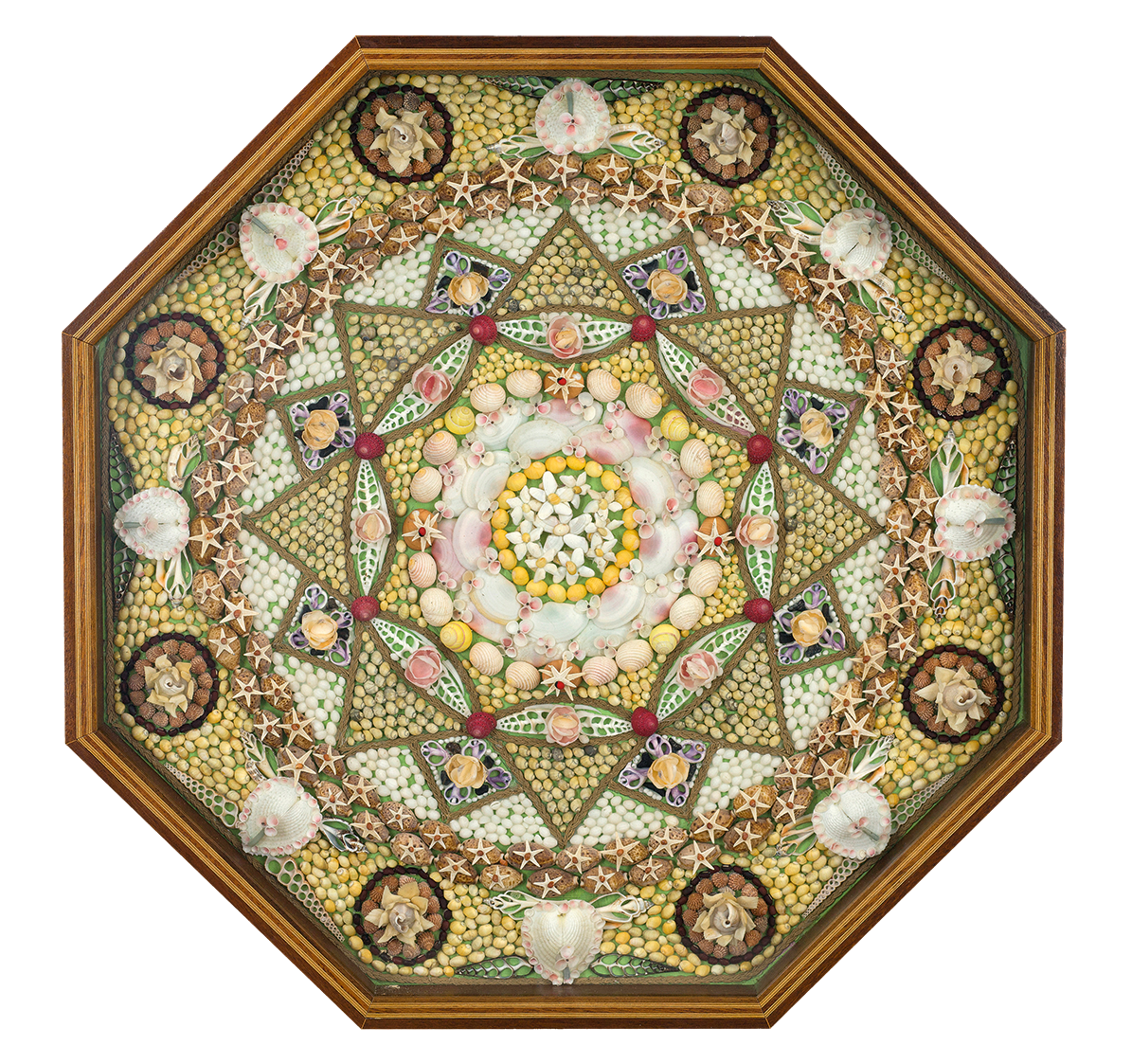Shell Company
The past, present, and future of selling seashell art
By Ellen LibermanMELONIE MASS A STARTS WITH A CAPIZ SHELL the size of a quarter. The flat, iridescent Capiz is the carapace of the windowpane oyster, which lives in the mud flats off the Philippines. They have been clustered in service to thousands of chandeliers, but Massa uses them as the foundation of her tiny shell sculptures.
The work table in the studio-cum-bedroom of her Bristol home is a seemingly random hardscape of nerites, rose cups, abalone, cockles, limpets, and cowries. With the claws-first posture of a diving osprey, Massa’s tweezers deftly pluck a tiny clam shell from the middens.
Five outer petals cup four inner petals and in about a minute, a creamy apple blossom emerges. She aims her professional grade hot-glue gun at the center to affix a pearl—the stigma of her facsimile flower. It is now ready to be dangled from an earring wire, or added to others on a hair clasp, packaged, and sold.

A sailor’s valentine by Melonie Massa
“Shell-work is my full-time salary, but I have to hustle,” she says.
Humans have invested the exoskeletons of marine mollusks with value for literally thousands of years. In some cultures, shells were currency, such as the cowrie in Africa and China. The Phoenicians did a brisk trade in murex shells, crushed and boiled for the purple dye that became the color of royalty.
But shells were also much prized as decorative objects to be collected and treasured for their own sakes or combined with precious stones and encrusted on other objects.
The Dutch, who famously turned their passion for tulips into speculative fortunes, did the same for shells in the 17th century, when the era of exploration and east-west trade routes brought shell exotica back from Indonesia. Rare specimens were once so valued that they fetched a higher price than paintings by Dutch masters Jan Steen and Frans Hals at one 18th century auction.
Image below “Star Heart” by Gregg Roberts. A contemporary sailor’s valentine style featuring multi-shelled natural colorations of varied dimension set in a hand crafted inlaid mahogany frame. It’s design includes a row of beige braided waxed linen roping and 16 three dimensional floret arrangements of two designs. Eight white hearts surround an elevated eight point star encircling a pink and white flower center.
Photograph courtesy of The Gallery at Tree’s Place
SAILOR'S VALENTINE
Sailor’s Valentines are a form of sea shell art, popular in the 1800s, when sailors brought them home to their wives, girlfriends, mothers, or sisters.
Most Sailor’s Valentines were made in the West Indies, on the island of Barbados, between 1830 and 1880, but production continued into the early 20th century.
The Victorians were no less mad about shells. Conchylomania gripped collectors who filled their cabinets of curiosities with the wonders of marine life. Ladies scoured Britain’s beaches for the materials to make decorative objects, such as shell flower bouquets, shell dolls and entire shell grottos; shell merchants supplied materials from far flung coasts.
“Seashells and the marine animals that make them have wound through human economy from the beginning of time,” says Cynthia Barnett, author of The Sound of the Sea: Seashells and the Fate of the Oceans. “Shells were jewelry before gems, art before canvas, and money before metal coins.”
Massa stepped into this historic lineage in 2009, when she opened her Etsy-based business, Mermaid’s Baubles, selling sailor’s valentines. Massa had always loved and collected shells, accumulating in glass jars to no particular design or purpose. Then, in 2007, on a visit to the New Bedford Whaling Museum it was right in front of her face–a kaleidoscopic picture made by hundreds of shells radiating under glass from the center of an octagonal wooden box.
“I stood in front of that exhibit, frozen,” she recalls. “I thought: ‘I want to do that.’”
SEASHELLS HAVE WOUND THROUGH HUMAN ECONOMY FROM THE BEGINNING OF TIME.

Sailor’s Valentine by Gregg Roberts. Photograph courtesy of The Gallery at Tree’s Place
Sailor’s valentines, which often bear a sentimental message such as “Love the Giver” or “Home Sweet Home,” were once romanticized as the handicraft of below-decks working men. They were actually made by the women of Barbados and sold to sailors as souvenirs.
This myth persisted until about 60 years ago, when one was discovered with a label on its back: “B.H. Belgrave, Dealer in Marine Specimens … Bridgetown, Barbados.”
Sailor’s valentines circulated from the Caribbean during the latter half of the 19th century, riding the dramatic rise and fall of the whaling industry and coming ashore in ports like New Bedford, once the nation’s whaling capital.
“This is the artistic blue economy,” says Benedict Leca, executive director of the Redwood Library & Anthenæum, who curated a recent exhibit of contemporary sailor’s valentines created by Newport resident Happy van Buren.
“No sailor on a whaling ship was picking out shells with tweezers. In many ways, sailor’s valentines represent the crossroads between longstanding Indigenous craft traditions and [Western] commercialization. The octagonal shape and the rigorously geometric image come from the Western half of the equation, based on the shipping octagonal boxes for the compass and perhaps a relationship to colonial sewing boxes.”
In the 1970s, contemporary shell artists began to revive the artform, says Anne Joffe, a shell dealer on Florida’s Sanibel Island for half a century, and a frequent judge in shellwork competitions.
For the next two years, Massa taught herself how to make sailor’s valentines, with the aid of library books so old they had to be pulled out of storage.
She experimented with different glues and resins to develop the right combination for maximum durability and brushed up on her math skills to ensure that her “messages” were centered, equal and properly curved.
Today, she sells the 9-inch versions for $350 apiece. As a matter of time and cost, sailor’s valentines are break-even propositions—at best. They take hours to make and the wooden boxes alone can cost up to $150 a piece—if you can find a carpenter to build them. A self-described “wicked shell geek,” Massa eventually decided that her flowers were far too beautiful to remain sequestered under glass, and began to turn them into shell wearables, fashioning jewelry and hair pieces. They now make up the bulk of her business, sold at local shops, online, and at craft shows.
Her colleague and mentor, Cape Cod shell artist Gregg Roberts, is also self-taught. A retired pharmacist, he developed a sudden desire to create sailor’s valentines after a dream recalling a real-life childhood encounter with one at a museum. From his first valentine—created with $60 worth of macaroni—Roberts’ works now command as high as $20,000 for a private commission.
In 2008, he created what has been billed as the world’s largest sailor’s valentine for Roger Williams University. Hanging in the campus’ Global Heritage Hall, it is 48 inches across —“as big as a card table” Roberts says. Comprised of about 1,000 shells arranged in an intricate design, it took Roberts over five months of full-time work and features his signature fancy nautical knotwork.
Roberts also lectures about the history of sailor’s valentines and teaches classes in how to make them.
“Making sailor’s valentines has a lot to do with sizing, design, inventory, creativity. It encompasses all different kinds of talents,” he says. And oddly, as one of his doctors once observed, its repetitive activity resembles pill-dispensing in a pharmacy. “You have to do the same thing a million times over, precisely and accurately. It’s tedious work, but the gist [of it] is working on a micro level and being able to envision it on a wall from five feet away. It’s a maritime art form. But, it’s difficult to sell because it’s expensive.”
More commonly, shellwork is a part-time job.
Grace Bramhall of East Greenwich, sells oyster shell ornaments, gilded on the back and decoupaged in the concave interior. This past holiday season she featured vintage maps of Rhode Island coastal towns, which she created using a computer graphic program. Bramhall, who graduated from the University of Rhode Island with a degree in art and art history, works full time as a behavioral technician for special needs children, but she had always had a side business selling other crafts.
Today she markets her shellwork at her Etsy store, The Tilly House.
“I got the idea from living on the Cape—oyster shells were so easily accessible, and during covid, we spent a lot of time on the beaches,” she says. “The shells took off.”
Sarah McClutchy was an oyster connoisseur, whose fascination with the bivalves ranged from the nuances of terroir to their role in the marine ecosystem. Like Bramhall, she turned them into a cottage-art ornament business during the covid lockdowns of 2020.
“I had so much anxiety—spending way too much time watching television and doom-scrolling. I needed a hobby that was safe, and [I needed] an escape. We had all these shells left over from buying oysters from oyster farmers that went into selling directly to consumers,” she recalled. “I started decoupaging shells, and as the weeks dragged on, I thought ‘what am I going to do with all these shells?’”
She starts by scrubbing them clean and soaking them in a beach solution to kill any decomposing organic matter. McClutchy then sources the most unusual and colorful rice paper napkins she can find to become the decoupaged center.
Last winter, her Newport-based business, Gilded Oysters, shipped more than 275 ornaments to 23 states as far as the West Coast, and to seven countries for $20-$25 apiece; she donated some of her profits to Save The Bay.
“People love these things, and there’s a real market for them,” says McClutchy, a full-time writer and marketing consultant. “For me, it’s a way to feel like [I’m] doing something productive and give back. I love the circular aspect of it—upcycling and using the whole animal.”

A shell hair clasp by Melonie Massa.
Increasingly, the marine animals that produce shells are protected under the Convention on International Trade in Endangered Species of Wild Fauna and Flora. Also known as cites, the multilateral treaty protects more than 38,700 endangered plants and animals from exploitation in international trade—including many varieties of shells.
“There are two major types of the shell business: the specimen trade—where shells fetch as much as $25,000. Then there is the bulk trade, where shells are sold by the bag,” says José Leal, science director and curator of the Bailey-Matthews National Shell Museum. “In some cases, there is habitat destruction. For example, some cowries are associated with coral, and they will turn the corals upside down to get the shell, which kills the colony. It’s like cutting down the tree to get a bird.”
Most bulk shells are exported from the Pacific Ocean’s Coral Triangle—between Papua New Guinea, Indonesia, and the Philippines—where some countries have tried to clamp down on the black market. In March 2021, for example, Philippine law enforcement seized $3.3 million worth of illegally harvested giant clam shells discovered in a remote village in the Palawan archipelago, likely destined for China, where they are carved as a substitute for ivory.
I MAKE IT A RULE TO NEVER PICK UP LIVE SPECIMENS. I WANT TO MAKE SURE THESE THINGS GET A CHANCE TO REPRODUCE.
Over 50 years in the business, Joffe has seen the shell trade change radically. She once bought her inventory directly from dealers all over the world—enough to stock her four shell shops. But in the last decade, environmental degradation, rising shipping costs, and species protection laws have greatly diminished shell exports from source countries. She’s now down to one shop, with lots of non-shell items, such as t-shirts, to fill the shelves.
“I’d go out with the shell dealer and the fisherman in boats and haul them up in nets and pack as much as I could in my suitcase. I also started importing 40-foot containers—that’s a lot of shells,” she says. “Then regulations started coming, and the cites list. I cannot get a lot of things—like a chambered nautilus—because it is against the law. Shells I used to buy for a $1 are now $5 apiece. A lot of us in the shell business are seeing the end coming.”
Saving the shell trade from over-collection will require more than bans, says Barnett. Shelling is a survival strategy for the fishers, who typically come from impoverished communities. Rather than take away their livelihoods, a better approach is to “empower them,” she says.
A pilot aquaculture project, supported by the National Oceanic and Atmospheric Administration, is working with the fishers of Naguabo, Puerto Rico, to raise Queen Conchs—desirable for their meat and shells.
“They are training the fishers themselves to run the hatcheries,” says Barnett. “And that could be part of the solution—a sustainable way of growing the Queen Conch and helping to restore the population.”
Massa is mindful of these threats as she hunts for the raw materials of her art.
“I look for people selling older stashes of shells, and I’m very careful about what I pick up,” says Massa. “I make it a rule never to pick up live specimens. I want to make sure these things get a chance to reproduce so I can keep doing what I’m doing. The sustainability of our art is a concern. We are dealing with something natural. It’s not an infinite resource.”
Contact Us
Telephone: (401) 874-6805
Email: allard@uri.edu
Contributor Guidelines
Please review submission guidelines to be considered. d

